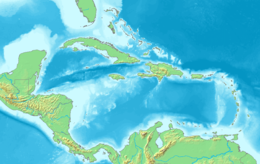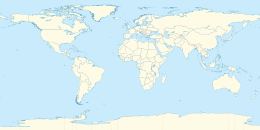Nickname: Amona | |
|---|---|
 Mona and Monito | |
| Geography | |
| Location | Caribbean |
| Coordinates | 18°5′12″N 67°53′22″W / 18.08667°N 67.88944°W |
| Archipelago | Puerto Rico |
| Area | 57 km2 (22 sq mi) |
| Length | 11 km (6.8 mi) |
| Width | 7 km (4.3 mi) |
| Administration | |
United States | |
| Commonwealth | Puerto Rico |
| Municipality | Mayagüez |
| Barrio | Isla de Mona e Islote Monito |
| Demographics | |
| Population | 5 (2010) |
| Designated | December 17, 1993 |
| Reference no. | 93001398[1] |
| Designated | 1975 |
pushpin_map, map.Mona Island (Spanish: Isla de Mona) is the third-largest island of the Puerto Rican archipelago, after the main island of Puerto Rico and Vieques. It is the largest of three islands in the Mona Passage, the strait between Hispaniola and Puerto Rico, with the others being Monito Island and Desecheo Island. It measures about 7 miles by 4 miles (11 km by 7 km), and lies 41 mi (66 km) west of Puerto Rico, of which it is administratively a part. It is one of two islands that make up the Isla de Mona e Islote Monito barrio in the municipality of Mayagüez.

The island is managed under the Mona and Monito Islands Nature Reserve (Reserva Natural Islas de Mona y Monito).[2] There are no permanent inhabitants; only rangers and biologists from the Puerto Rico Department of Natural and Environmental Resources reside on the island, to manage visitors and take part in research projects. The island, along with Monito, form part of the Mona and Monito Islands National Natural Landmark[3] which recognizes and preserves the islands' ecosystem as an outstanding example of diversity and natural history.[4] The island is home to a number of endemic species such as the Mona ground iguana and it is an important seabird area.[5]
- ^ "National Register Information System". National Register of Historic Places. National Park Service. March 13, 2009.
- ^ "Reserva Natural Isla de Mona" [Mona Island Nature Reserve] (in Spanish). Archived from the original on June 30, 2016. Retrieved June 9, 2016.
- ^ "National Natural Landmarks – National Natural Landmarks (U.S. National Park Service)". www.nps.gov. Retrieved November 28, 2021.
- ^ "National Natural Landmarks (U.S. National Park Service)". www.nps.gov. Retrieved November 28, 2021.
- ^ "Mona Island, Puerto Rico". Island Conservation. Retrieved November 28, 2021.




